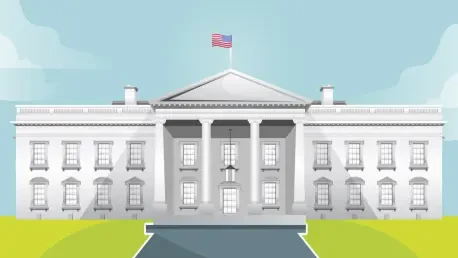What happens when the backbone of the U.S. government teeters on the edge of collapse, leaving hundreds of thousands of federal workers staring into an abyss of uncertainty with no clear resolution in sight? A staggering 737,000 employees—nearly a third of the federal workforce—could face furloughs or permanent layoffs if a government shutdown strikes. This isn’t a distant threat but a looming crisis, as the White House has issued a stark directive to federal agencies to brace for mass workforce reductions. The tension in Washington is palpable, and the stakes for ordinary workers have never been higher.
A Critical Deadline for Federal Workers: Why This Shutdown Threat Stands Apart
The clock is ticking, and the atmosphere among federal employees is thick with dread. Unlike previous budget impasses, the current White House directive, channeled through the Office of Management and Budget (OMB), carries a chilling weight. Agencies have been instructed to prepare for a potential shutdown with plans that could upend lives overnight, setting this crisis apart from past standoffs where temporary solutions often softened the blow.
This time, the administration’s tone suggests little room for compromise. With partisan gridlock paralyzing Congress, the risk of a funding lapse feels more immediate. Federal workers, from park rangers to data analysts, are left wondering if their next paycheck will be their last, as the government’s operational heartbeat hangs in the balance.
The High Stakes of a Shutdown: Politics, Funding, and Human Toll
At the core of this crisis lies a bitter political deadlock. The House recently passed a stopgap funding bill to keep agencies running until November 21, but Senate Democrats halted it, citing demands for action on unrelated issues like rising health care premiums. This standoff has pushed the nation to the brink, with no clear resolution in sight.
Beyond the political maneuvering, the human cost looms large. The OMB’s directive to draft reduction in force (RIF) notices and furlough plans signals a harsh reality for federal employees. This isn’t merely about delayed pay; it’s about the potential unraveling of careers and financial stability, exposing a deeper ideological battle over the scope of government itself.
The administration’s stance appears unyielding, with instructions that deviate sharply from past practices. During earlier shutdowns, creative funding measures often minimized disruptions, but such options are now explicitly off the table. This hardline approach underscores a deliberate push to reshape the federal landscape, leaving workers as pawns in a larger chess game.
Unpacking the Directive: Layoffs, Furloughs, and a Shrinking Workforce
The OMB’s guidance is both broad in scope and precise in its targets, focusing on employees whose roles depend on annual appropriations or fall outside President Trump’s stated priorities. Immediate furloughs could impact around 737,000 workers, based on recent Government Executive data, while RIF notices signal permanent cuts for some—a step beyond the temporary measures seen in prior crises.
Long-term plans are even more sobering. Agencies are directed to maintain minimal staffing for essential functions well into fiscal 2027 and beyond, aligning with earlier calls from the administration to eliminate roles deemed non-essential. This isn’t just crisis management; it’s a calculated strategy to downsize the federal workforce permanently.
The ban on alternative funding solutions adds another layer of severity. Unlike past shutdowns where agencies found ways to cushion the impact, the current mandate leaves little wiggle room. This shift raises pressing questions about the sustainability of vital government services and the future for those who provide them.
Echoes from the Field: Criticism, Compliance, and Growing Anxiety
Reactions to the directive span a wide spectrum, reflecting deep divisions. Senate Minority Leader Chuck Schumer has condemned the layoff threats as a form of intimidation, arguing they serve political ends rather than practical governance. He points to historical precedents where similar plans faced legal pushback or were ultimately abandoned, predicting a rocky road ahead for the administration’s approach.
Agency responses are far from uniform, adding to the confusion. While the Interior Department is moving aggressively to prepare for significant layoffs, other agencies have taken a more cautious stance, scaling back their planning efforts. This inconsistency fuels uncertainty, as federal employees struggle to discern the true scale of the threat they face.
Compounding the unease is a lack of transparency. The OMB’s decision to remove detailed furlough plans from public view, coupled with delayed submissions from several agencies, leaves workers in the dark. As one anonymous employee shared, the waiting game is excruciating, with many feeling like their livelihoods are subject to political whims rather than reasoned policy.
Charting a Path Through Uncertainty: Steps for Workers and Agencies
Amid the chaos, actionable measures can help mitigate the fallout for those in the crosshairs. Federal employees are encouraged to assess their financial readiness, building emergency savings to weather potential furloughs. Staying updated via union channels or official agency memos is critical, as is documenting work contributions to bolster defenses against possible layoffs.
Agencies, meanwhile, bear a responsibility to cut through the fog. Expediting clear communication about furlough and RIF plans, even if details remain fluid, can reduce panic among staff. Identifying essential functions now—rather than scrambling at the last minute—will help prioritize staffing and maintain core operations under strain.
Both workers and agencies must keep a close eye on legislative developments, as a last-minute funding agreement could derail these drastic preparations. Legal resources and union support may also offer avenues for recourse if layoffs are seen as unjust. While these steps can’t erase the looming threat, they provide a framework to navigate an unprecedented storm with some measure of control.
Reflecting on a Crisis Point
Looking back, the standoff over government funding revealed a profound rift in Washington, with federal workers caught in the crossfire of political brinkmanship. The White House’s directive to prepare for mass layoffs and furloughs underscored a harsh reality for hundreds of thousands, while partisan gridlock stalled any hope of a swift resolution. The varied responses from agencies and sharp criticism from figures like Chuck Schumer painted a picture of disarray and contention.
Yet, amid the turmoil, a path forward emerged through practical preparation and vigilance. Federal employees who took steps to safeguard their finances and stay informed found some footing, while agencies that prioritized clarity helped ease the burden of uncertainty. Moving ahead, sustained advocacy for fair treatment and close monitoring of legislative outcomes remain essential to prevent such a crisis from spiraling further.
The lasting lesson was clear: resilience and proactive engagement could make a difference, even in the face of systemic challenges. As the dust settled, the focus shifted toward ensuring that the human cost of political battles would not be overlooked, urging a renewed commitment to protecting the backbone of public service in any future storms.









